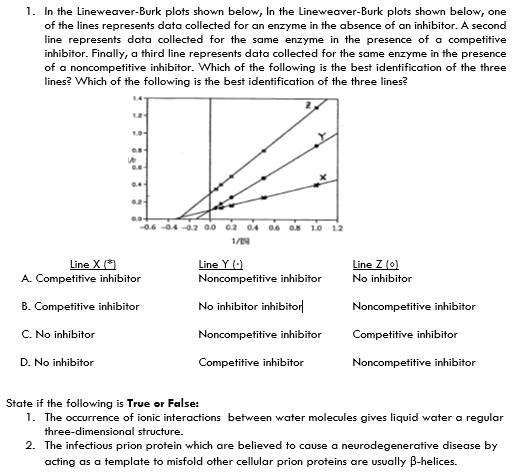1. In the Lineweaver-Burk plots shown below, In the Lineweaver-Burk plots shown below, one of the lines represents data collected for an enzyme in the absence of an inhibitor. A second line represents data collected for the same enzyme in the presence of a competitive inhibitor. Finally, a third line represents data collected for the same enzyme in the presence of a noncompetitive inhibitor. Which of the following is the best identification of the three lines? Which of the following is the best identification of the three lines? 0.6 -0.4 -0.2 a0 02 04 06 Os 10 12 1/N Line X (*) A. Competitive inhibitor Line Y () Noncompetitive inhibitor Line Z (0) No inhibitor B. Competitive inhibitor No inhibitor inhibitor Noncompetitive inhibitor
1. In the Lineweaver-Burk plots shown below, In the Lineweaver-Burk plots shown below, one of the lines represents data collected for an enzyme in the absence of an inhibitor. A second line represents data collected for the same enzyme in the presence of a competitive inhibitor. Finally, a third line represents data collected for the same enzyme in the presence of a noncompetitive inhibitor. Which of the following is the best identification of the three lines? Which of the following is the best identification of the three lines? 0.6 -0.4 -0.2 a0 02 04 06 Os 10 12 1/N Line X (*) A. Competitive inhibitor Line Y () Noncompetitive inhibitor Line Z (0) No inhibitor B. Competitive inhibitor No inhibitor inhibitor Noncompetitive inhibitor
Biology: The Dynamic Science (MindTap Course List)
4th Edition
ISBN:9781305389892
Author:Peter J. Russell, Paul E. Hertz, Beverly McMillan
Publisher:Peter J. Russell, Paul E. Hertz, Beverly McMillan
Chapter6: Energy, Enzymes, And Biological Reactions
Section: Chapter Questions
Problem 9TYK: Which of the following statements about inhibition is true? a. Allosteric inhibitors and allosteric...
Related questions
Question

Transcribed Image Text:1. In the Lineweaver-Burk plots shown below, In the Lineweaver-Burk plots shown below, one
of the lines represents data collected for an enzyme in the absence of an inhibitor. A second
line represents data collected for the same enzyme in the presence of a competitive
inhibitor. Finally, a third line represents data collected for the same enzyme in the presence
of a noncompetitive inhibitor. Which of the following is the best identification of the three
lines? Which of the following is the best identification of the three lines?
0.6 -0.4 -0.2 a.0 02 04 06 ON 10 12
1/
Line Y ()
Noncompetitive inhibitor
Line X (*)
Line Z (o)
A. Competitive inhibitor
No inhibitor
B. Competitive inhibitor
No inhibitor inhibitor|
Noncompetitive inhibitor
C. No inhibitor
Noncompetitive inhibitor
Competitive inhibitor
D. No inhibitor
Competitive inhibitor
Noncompetitive inhibitor
State if the following is True or False:
1. The occurrence of ionic interactions between water molecules gives liquid water a regular
three-dimensional structure.
2. The infectious prion protein which are believed to cause a neurodegenerative disease by
acting as a template to misfold other cellular prion proteins are usually B-helices.
Expert Solution
This question has been solved!
Explore an expertly crafted, step-by-step solution for a thorough understanding of key concepts.
Step by step
Solved in 3 steps

Recommended textbooks for you

Biology: The Dynamic Science (MindTap Course List)
Biology
ISBN:
9781305389892
Author:
Peter J. Russell, Paul E. Hertz, Beverly McMillan
Publisher:
Cengage Learning

Biology: The Dynamic Science (MindTap Course List)
Biology
ISBN:
9781305389892
Author:
Peter J. Russell, Paul E. Hertz, Beverly McMillan
Publisher:
Cengage Learning